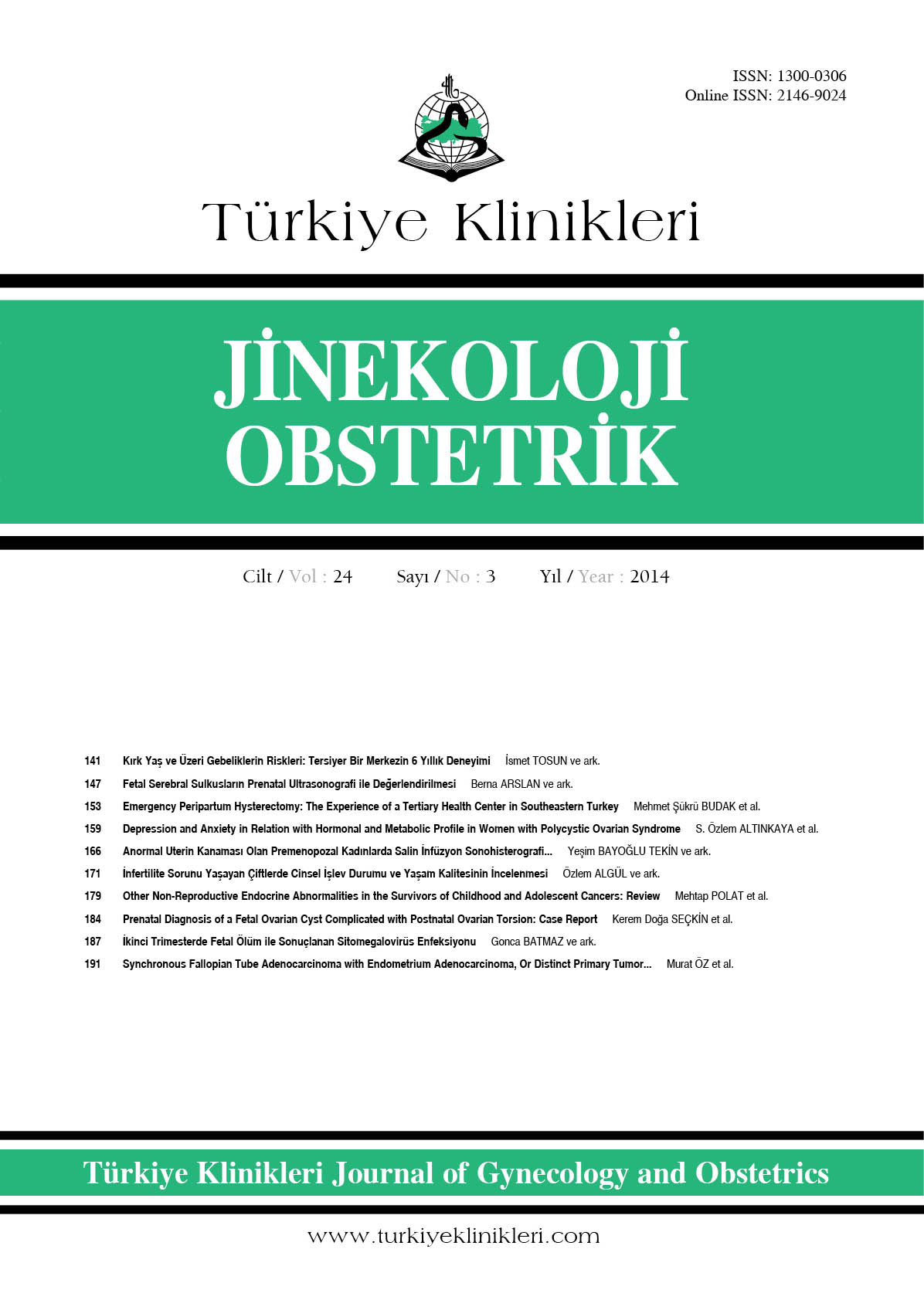Open Access
Peer Reviewed
ORIGINAL RESEARCH
2176 Viewed1049 Downloaded
Emergency Peripartum Hysterectomy: The Experience of a Tertiary Health Center in Southeastern Turkey
Acil Peripartum Histerektomi: Güneydoğu Anadolu Bölgesi'ndeki Bir Üçüncü Basamak Sağlık Merkezinin Deneyimi
Turkiye Klinikleri J Gynecol Obst. 2014;24(3):153-8
Article Language: EN
Copyright Ⓒ 2025 by Türkiye Klinikleri. This is an open access article under the CC BY-NC-ND license (http://creativecommons.org/licenses/by-nc-nd/4.0/)
ABSTRACT
Objective: The present study aims to review the emergency peripartum hysterectomies which were performed at a tertiary health center located in southeastern Turkey within a period of 22 months. Material and Methods: This is a retrospective analysis of 32 emergency peripartum hysterectomies (18 total hysterectomies and 14 subtotal hysterectomies) which were performed at Diyarbakır Maternity Hospital between January 2012 and November 2013. Results: The overall incidence of emergency peripartum hysterectomy was computed to be 0.82 among 1000 births. The rates of placental abruption, abnormal placentation and cephalopelvic disproportion were significantly higher in women undergoing emergency peripartum hysterectomy (p<0.001 for each). The most frequent indications were uterine atony (67.8%), uterine rupture (18.7%) and abnormal placentation (12.5%) respectively. The most common indications for total hysterectomy were uterine atony (55.6%), uterine rupture (22.2%) and abnormal placentation (22.2%) whereas uterine atony (85.7%) and uterine rupture (14.3%) were the most frequent indications for subtotal hysterectomy (p=0.110). The overall morbidity rate was 9.4% and maternal mortality rate was 3.1%. Conclusions: Uterine atony is the most frequent cause of emergency peripartum hysterectomy in southeastern Turkey. Uterine atony is associated with advanced age, increased parity and present cesarean delivery.
Objective: The present study aims to review the emergency peripartum hysterectomies which were performed at a tertiary health center located in southeastern Turkey within a period of 22 months. Material and Methods: This is a retrospective analysis of 32 emergency peripartum hysterectomies (18 total hysterectomies and 14 subtotal hysterectomies) which were performed at Diyarbakır Maternity Hospital between January 2012 and November 2013. Results: The overall incidence of emergency peripartum hysterectomy was computed to be 0.82 among 1000 births. The rates of placental abruption, abnormal placentation and cephalopelvic disproportion were significantly higher in women undergoing emergency peripartum hysterectomy (p<0.001 for each). The most frequent indications were uterine atony (67.8%), uterine rupture (18.7%) and abnormal placentation (12.5%) respectively. The most common indications for total hysterectomy were uterine atony (55.6%), uterine rupture (22.2%) and abnormal placentation (22.2%) whereas uterine atony (85.7%) and uterine rupture (14.3%) were the most frequent indications for subtotal hysterectomy (p=0.110). The overall morbidity rate was 9.4% and maternal mortality rate was 3.1%. Conclusions: Uterine atony is the most frequent cause of emergency peripartum hysterectomy in southeastern Turkey. Uterine atony is associated with advanced age, increased parity and present cesarean delivery.
ÖZET
Amaç: Bu çalışma, 22 aylık dönem içinde, Güneydoğu Anadolu Bölgesi'nde yer alan bir üçüncü basamak sağlık merkezinde gerçekleştirilen acil peripartum histerektomileri değerlendirmeyi amaçlamaktadır. Gereç ve Yöntemler: Ocak 2012 ve Kasım 2013 tarihleri arasında Diyarbakır Kadın Doğum ve Çocuk Hastalıkları Hastanesi'nde gerçekleştirilen 32 acil peripartum histerektomi (18 total histerektomi ve 14 subtotal histerektomi) geriye dönük olarak incelenmiştir. Bulgular: Acil peripartum histerektomi insidansı, 1000 doğumda 0,82 olarak hesaplanmıştır. Acil peripartum histerektomi uygulanan hastalarda abruptio plasenta, anormal plasentasyon ve sefalopelvik uyumsuzluk oranı anlamlı olarak daha yüksekti (her biri için p<0,001). En sık saptanan acil peripartum histerektomi endikasyonları, sırasıyla uterin atoni (%67,8), uterin rüptür (%18,7) ve anormal plasentasyon (%12,5) olarak belirlendi. En sık görülen total histerektomi endikasyonları; sırasıyla uterin atoni (%55,6), uterin rüptür (%22,2) ve anormal plasentasyon (%22,2) olarak saptanırken en sık görülen subtotal histerektomi endikasyonları ise sırasıyla uterin atoni (%85,7) ve uterin rüptür (%14,3) idi (p=0,110). Toplam morbidite oranı ve maternal mortalite oranı sırasıyla %9,4 ve %3,1 olarak bulundu. Sonuç: Güneydoğu Anadolu Bölgesi'nde gerçekleştirilen acil peripartum histerektomilerin en sık nedeni, uterus atonisidir. Uterus atonisi; ileri yaş, artmış parite ve şu andaki sezaryenle doğum ile ilişkilidir.
Amaç: Bu çalışma, 22 aylık dönem içinde, Güneydoğu Anadolu Bölgesi'nde yer alan bir üçüncü basamak sağlık merkezinde gerçekleştirilen acil peripartum histerektomileri değerlendirmeyi amaçlamaktadır. Gereç ve Yöntemler: Ocak 2012 ve Kasım 2013 tarihleri arasında Diyarbakır Kadın Doğum ve Çocuk Hastalıkları Hastanesi'nde gerçekleştirilen 32 acil peripartum histerektomi (18 total histerektomi ve 14 subtotal histerektomi) geriye dönük olarak incelenmiştir. Bulgular: Acil peripartum histerektomi insidansı, 1000 doğumda 0,82 olarak hesaplanmıştır. Acil peripartum histerektomi uygulanan hastalarda abruptio plasenta, anormal plasentasyon ve sefalopelvik uyumsuzluk oranı anlamlı olarak daha yüksekti (her biri için p<0,001). En sık saptanan acil peripartum histerektomi endikasyonları, sırasıyla uterin atoni (%67,8), uterin rüptür (%18,7) ve anormal plasentasyon (%12,5) olarak belirlendi. En sık görülen total histerektomi endikasyonları; sırasıyla uterin atoni (%55,6), uterin rüptür (%22,2) ve anormal plasentasyon (%22,2) olarak saptanırken en sık görülen subtotal histerektomi endikasyonları ise sırasıyla uterin atoni (%85,7) ve uterin rüptür (%14,3) idi (p=0,110). Toplam morbidite oranı ve maternal mortalite oranı sırasıyla %9,4 ve %3,1 olarak bulundu. Sonuç: Güneydoğu Anadolu Bölgesi'nde gerçekleştirilen acil peripartum histerektomilerin en sık nedeni, uterus atonisidir. Uterus atonisi; ileri yaş, artmış parite ve şu andaki sezaryenle doğum ile ilişkilidir.
MENU
POPULAR ARTICLES
MOST DOWNLOADED ARTICLES





This journal is licensed under a Creative Commons Attribution-NonCommercial-NoDerivatives 4.0 International License.










